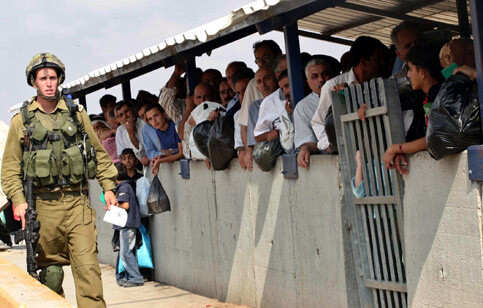The Electronic Intifada 11 December 2006

Palestinians wait to cross Huwara checkpoint near the West Bank city of Nablus, 15 October 2006. (MaanImages/Rami Swidan)
A strange phenomenon has been taking place over the past few years. Israel has been carrying out a systematic plan to try and separate Gaza from the West Bank. Little attention has been given to this effort separating people — and a country — using administrative measures.
This phenomenon began in the late 1980s with the launch of the Palestinian intifada, was accelerated in the beginning of the second intifada in 2000, and has been accelerated even more since the unilateral Israeli withdrawal from Gaza, causing a critical human and economic crisis.
Gaza, the West Bank, as well as Israel were part of historic Palestine. In 1948, with the creation of the State of Israel, they were abruptly divided. The Egyptian authorities were left to administer the Gaza Strip, whose population had been doubled as a result of the Nakba (catastrophe), sending Palestinian refugees from the southern towns of Palestine to Gaza.
On the other hand, the West Bank was held by Transjordan. In April 1949, Transjordan became the Hashemite Kingdom of Jordan, and one year later, in 1950, the West Bank became constitutionally an integral part of the Hashemite Kingdom of Jordan. While Egypt didn’t confer citizenship on the Palestinians of Gaza, West Bankers became Jordanian citizens.
All this changed after the June 1967 war. In an ironic twist of history, these two sectors of Palestine were reunited, albeit under Israeli occupation. Palestinians of Gaza and the West Bank were able to travel freely back and forth even though this meant going through the pre-‘67 Israeli territory. And since all were part of a single economic area, the movement of people and goods went on uninterrupted for tens of years.
Palestinians from Nablus or Hebron married and started families with fellow Palestinians from Gaza or Rafah. Students from Khan Yunis or Deir El-Balah attended universities in Bir Zeit or Al-Najah. Businesses in Ramallah or Hebron distributed their dairy products, stone, or toilet paper to the Gaza market, and trucks carrying bamboo furniture or sand made daily trips to Bethlehem or Jenin.
The 1991 Madrid Peace Conference and the 1993 Oslo Accords brought with them both a legal restriction of movement and a reaffirmation of the unity of Palestinian lands. The PLO-Israel Memorandum of Understanding devoted an entire chapter to routine safe passage to facilitate movement of people and goods. Signs were put up dedicating a special road between north Gaza and the Tarkumiya checkpoint, south of Hebron.
But all this seems like a charade now. Except for a few photo opportunities of a few buses traveling on the Gaza-West Bank route, the safe passage never materialized and the signs have entered the museum of Palestinian-Israeli failures.
Israel has never admitted it, but the plan for separating these two entities is obvious, even though largely underreported. Palestinians from Gaza wishing to travel to the West Bank, and vice versa, are unable to do so as a result of publicly-known as well as secret administrative decisions and guidelines.
Technically, of course, one can get the coveted permit to travel back and forth — but such passes were, I imagine, easier to come by in apartheid South Africa. Extreme humanitarian cases are often the only ones in which a limited time permit is allowed.
For a while Palestinians traveled from Gaza to the West Bank by flying from the Egyptian El-Arish airport and then crossing into the West Bank or vice versa, but even using nearby Arab countries is now administratively impossible. Democratically elected members of the Palestinian parliament, as well as many others have had to use video conferencing in order to communicate with fellow Palestinians. Only President Mahmoud Abbas and a few senior, “acceptable” PLO leaders have been allowed to travel into and out of Gaza.
What the Israelis hope to accomplish is unclear. Some feel they are still dreaming that one day Gaza will be administered by the Egyptians, and the West Bank by Jordan. Both Arab countries as well as all Palestinians vehemently oppose this.
And, in the meantime, Israel continues to violate the 13th clause of the Universal Declaration of Human Rights, which states “Everyone has the right to freedom of movement. You have the right to move about freely within your country. You also have the right to travel freely to and from your own country, and to leave any country.”
Daoud Kuttab is a Palestinian journalist and director of the Institute of Modern Media at Al Quds University in Ramallah. His website is www.daoudkuttab.com. This article was originally published by the Jerusalem Post and is reprinted with the author’s permission.
Related Links





